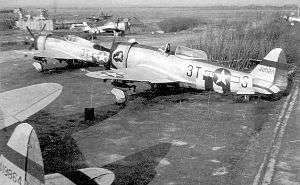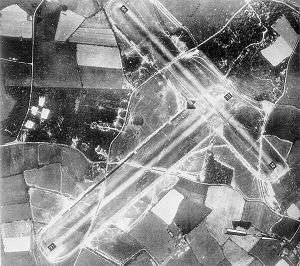RAF Kingsnorth (World War II)
| Royal Air Force Kingsnorth USAAF Station AAF-418  | |
|---|---|
| Located Near Kingsnorth, Kent, United Kingdom | |
|
Kingsnorth airfield, 12 May 1944, photo oriented to the west (top), taken about three weeks before D-Day. The crossroads in the middle of the picture is Bliby Corner, with Sevington Lane running left-right and Chequertree Lane going top-bottom. | |
 RAF Kingsnorth RAF Kingsnorth, shown within Kent | |
| Coordinates | 51°6′18″N 0°53′20″E / 51.10500°N 0.88889°ECoordinates: 51°6′18″N 0°53′20″E / 51.10500°N 0.88889°E |
| Type | Military airfield |
| Code | KN |
| Site information | |
| Controlled by |
|
| Site history | |
| Built | 1944 |
| In use | 1944 |
| Battles/wars |
European Theatre of World War II Air Offensive, Europe July 1942 - May 1945 |
| Garrison information | |
| Garrison |
RAF Fighter Command Ninth Air Force |
| Occupants |
Nos. 65, 122 and 602 squadrons 36th Fighter Group |
RAF Kingsnorth was a World War II airfield in Kent, England. The former Royal Air Force station was at Bliby Corner approximately 2 miles (3.2 km) southeast of Ashford; about 50 miles (80 km) southeast of London. It is not to be confused with RNAS Kingsnorth, later RAF Kingsnorth, which was an airship station in operation during and after World War I.
Opened in 1943, Kingsnorth was one of a number of prototype temporary Advanced Landing Ground airfields to be built in France after D-Day, as the Allied forces moved east across France and Germany. Kingsnorth was used by British, Dominion and the United States Army Air Forces until it was closed in September 1944.
Today the airfield is agricultural land with few remains visible on the ground, although sections of the runways can clearly be made out on aerial and satellite photos.
Overview
The USAAF Ninth Air Force required several temporary Advanced Landing Ground (ALG) along the channel coast prior to the June 1944 invasion of Normandy to provide tactical air support for the ground forces landing in France.
RAF Fighter Command use
| Unit | Dates | Aircraft | Variant | Notes |
|---|---|---|---|---|
| No. 19 Squadron RAF | August–September 1943 | Supermarine Spitfire | IX | [1] |
| No. 65 Squadron RAF | July–October 1943 | Supermarine Spitfire | IX | [2] |
| No. 122 Squadron RAF | July–October 1943 | Supermarine Spitfire | IX | [3] |
| No. 184 Squadron RAF | August 1943 | Hawker Hurricane | IV | [4] |
| No. 602 Squadron RAF | July–August 1943 | Supermarine Spitfire | VB | [5] |
USAAF use

Kingsnorth was known as USAAF Station AAF-418 for security reasons by the USAAF during the war, and by which it was referred to instead of location. Its USAAF Station Code was "KN".
36th Fighter Group
The availability date of 1 April 1944 was achieved and between the 4th and 6th of that month approximately 1,500 men of the 36th Fighter Group arrived at Kingsnorth airfield from Scribner Army Airfield, Nebraska. Operational fighter squadrons and fuselage codes were:
- 22d Fighter Squadron (3T)
- 23d Fighter Squadron (7U)
- 53d Fighter Squadron (6V)
The 36th Fighter Group was part of the 303d Fighter Wing, XIX Tactical Air Command.
Movement to the Continent commenced during the first week of July when the 53rd Fighter Squadron transferred to its Advanced Landing Ground (ALG) at Brucheville, France (ALG A-16) as a forward base. The other two squadrons continued to operate from Kingsnorth until early August, the main body of the group preparing to move on the 2nd. Within a few days all personnel were gone and the airfield was deserted.
Civil use
With the facility released from military control, the former airfield was returned rapidly to agricultural use and within a very short period there was little to indicate that RAF Kingsnorth had existed. Today the only evidence of the airfield's existence is a slight outline of the southeast end of runway 13, visible in aerial photographs.
Directions
Kingsnorth Airfield is on the east side of the A2070 just south of Ashford, about 1 mile south of Bad Munsterfeld road just after the loop heading southwards. The main airfield was in the field northwest of Bliby Corner crossroads, although the runways can be traced to south of Chequertree Lane.
See also
References
- Notes
- Bibliography
![]() This article incorporates public domain material from the Air Force Historical Research Agency website http://www.afhra.af.mil/.
This article incorporates public domain material from the Air Force Historical Research Agency website http://www.afhra.af.mil/.
- Freeman, Roger A. (1994) UK Airfields of the Ninth: Then and Now 1994. After the Battle ISBN 0-900913-80-0
- Freeman, Roger A. (1996) The Ninth Air Force in Colour: UK and the Continent-World War Two. After the Battle ISBN 1-85409-272-3
- Jefford, C G. RAF Squadrons, first edition 1988, Airlife Publishing, UK, ISBN 1-85310-053-6.
- Maurer, Maurer (1983). Air Force Combat Units Of World War II. Maxwell AFB, Alabama: Office of Air Force History. ISBN 0-89201-092-4.
- USAAS-USAAC-USAAF-USAF Aircraft Serial Numbers--1908 to present
- British Automobile Association (AA), (1978), Complete Atlas of Britain, ISBN 0-86145-005-1
External links
| Wikimedia Commons has media related to RAF Kingsnorth (WWII). |

.svg.png)